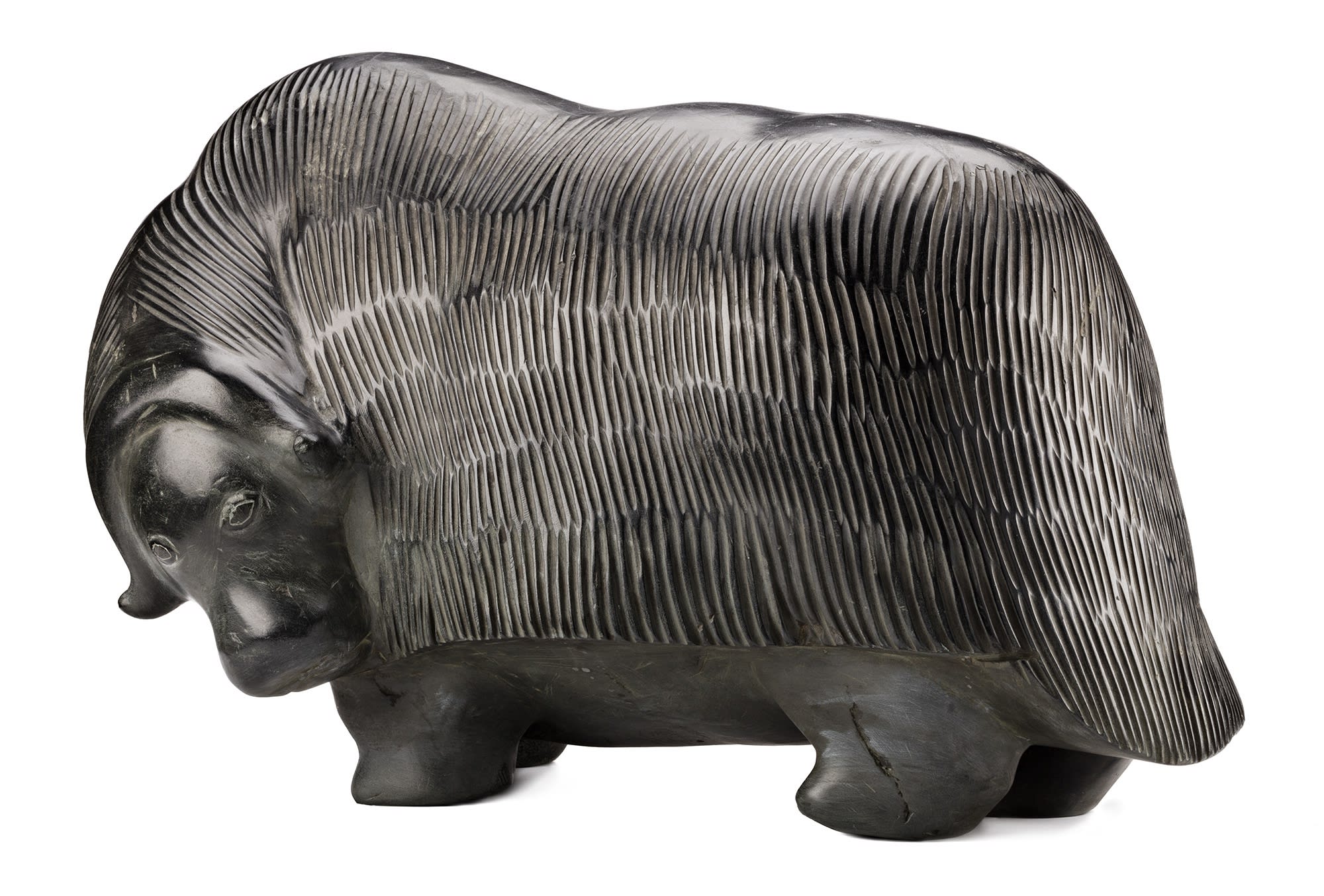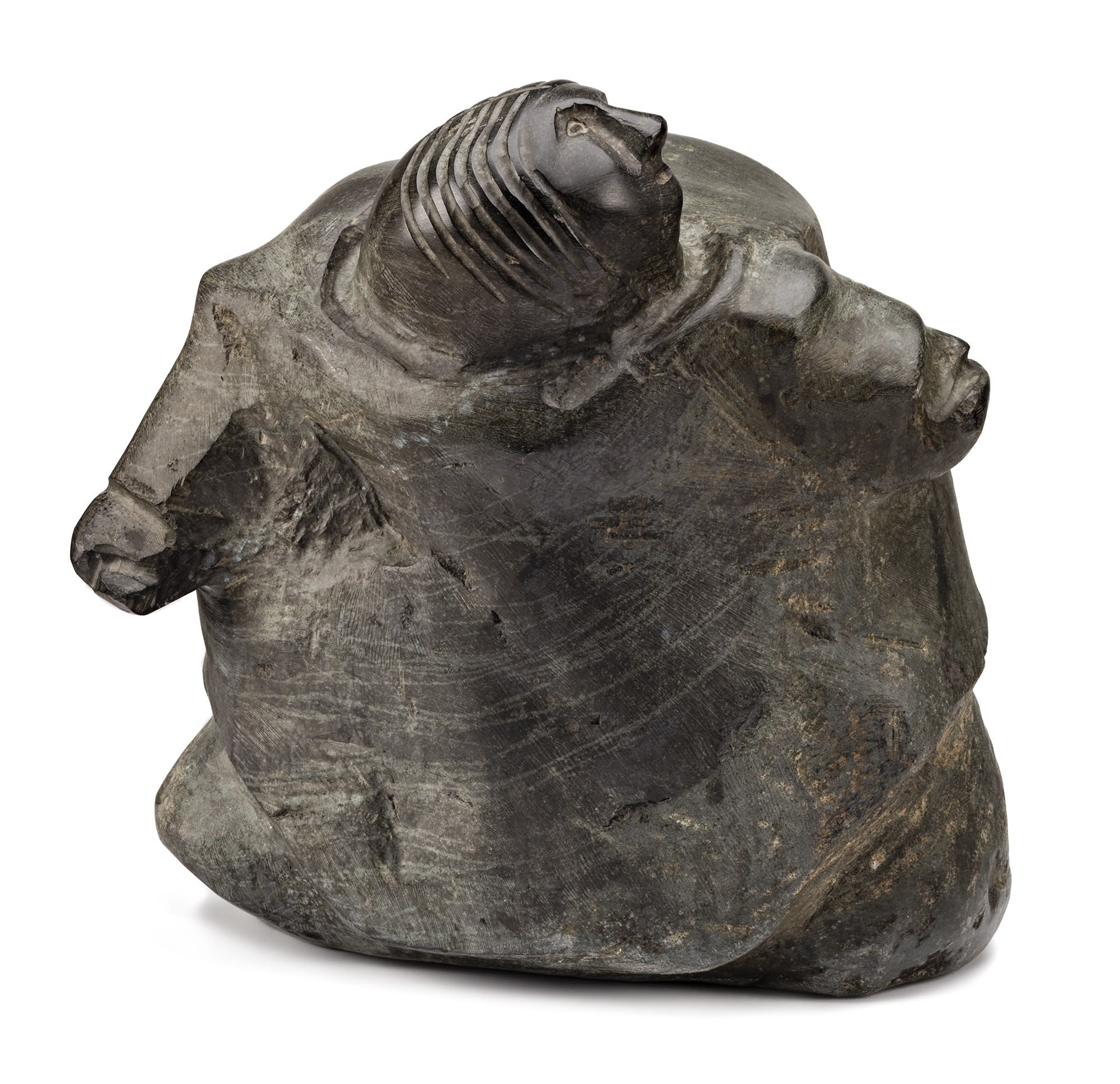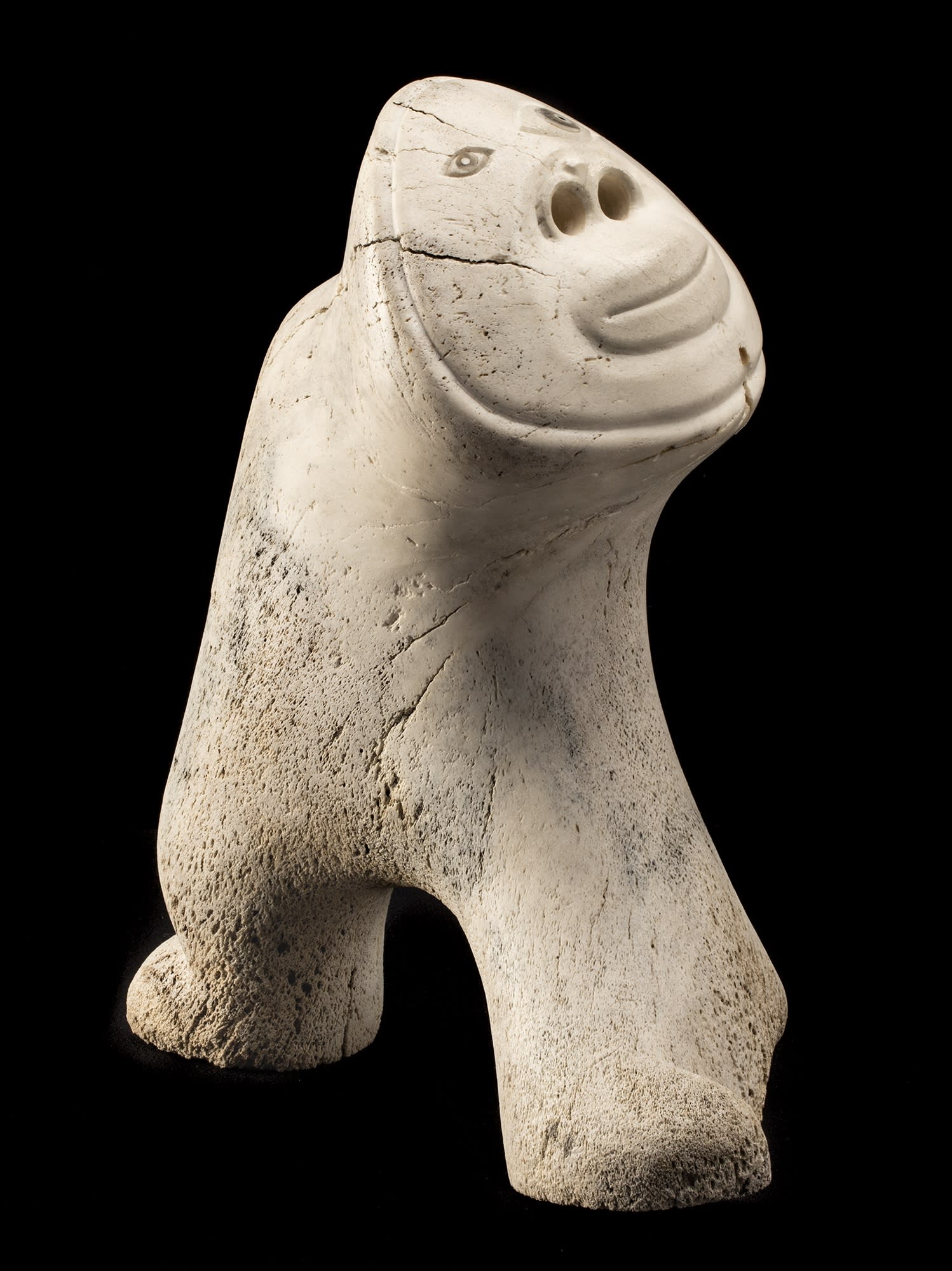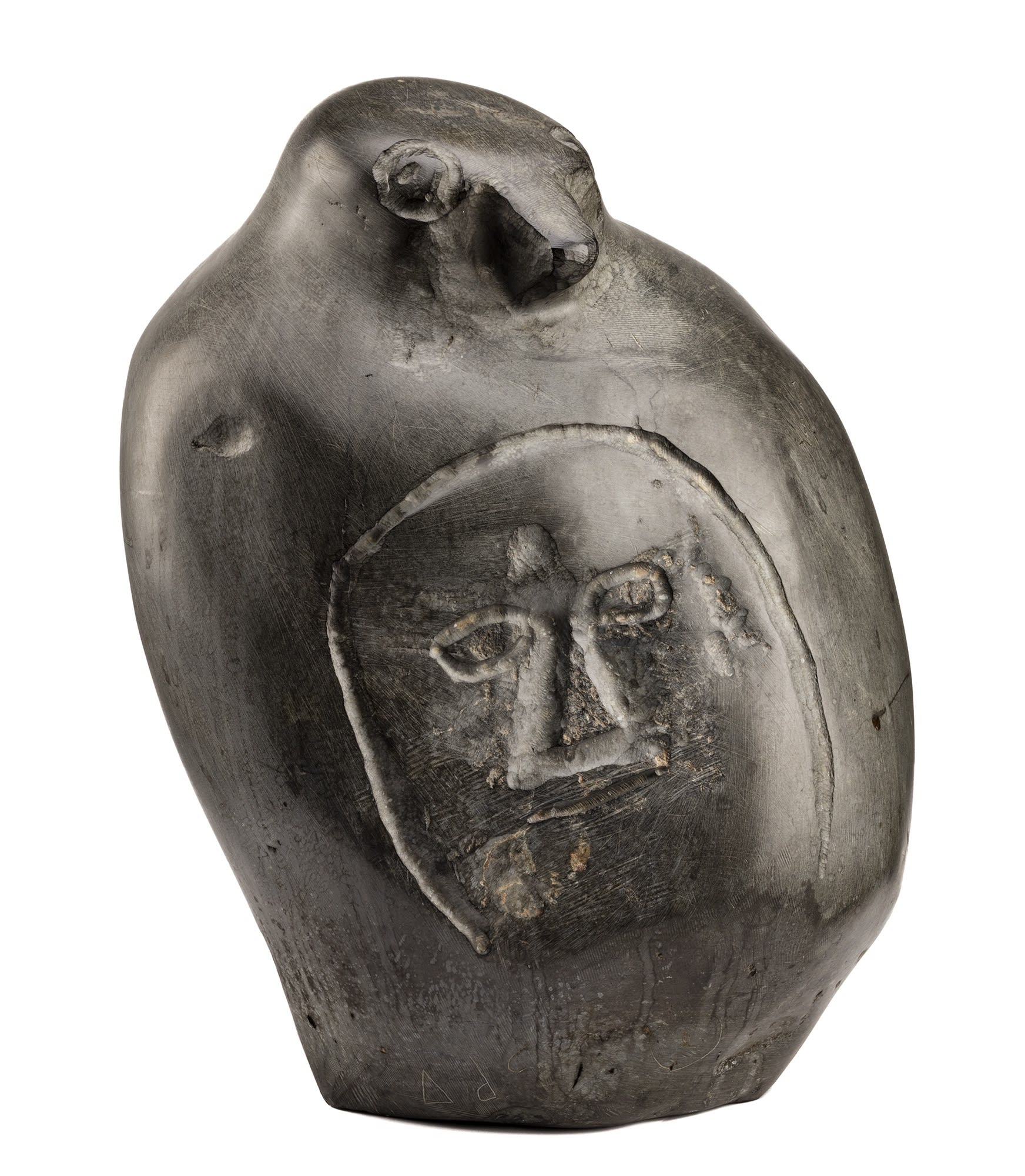
In my experience art collectors are like snowflakes, in that no two are alike. I have met collectors who have a singular focus on one artist, community, or subject, and others who have less stringent constraints. This wonderful group of sculptures was entrusted to First Arts by one of the most eclectic and uncompromising collectors that I have ever met. Ours is a relationship that goes back over forty years, beginning when I befriended a fellow student in a college art history course. Over the next several years I was a frequent visitor to her parents’ home where I always enjoyed my discussions with her very affable parents.
The house itself was a work of art, unlike any that I had seen before or since, with towering ceilings and filled with massive palm trees enjoying the light allowed in by the curtain wall construction. Every available inch of wall and counter space was filled with magnificent works of art from across the globe. There were entire sections of shelves filled with Pre-Columbian ceramics and others overflowing with sculptures from the American Southwest. The walls were crammed with American Pop artists, Latin American masters, and an impressive array of Canadian painters from the 60s and 70s, with much of the floor space devoted to large African sculptures.
Of course, the pieces that where nearest and dearest to me were the stunning Inuit sculptures in the collection. Scattered throughout the house were perhaps hundreds of sculptures ranging from dozens of superlative beaded works by Eva Talooki Aliktiluk, a smattering of small Joe Talirunili owls and Pauta Saila bears, to some of the largest and finest examples of works by Barnabus Arnasungaaq and Tuna Iquliq. The Inuit collection was no less eclectic than the rest of the artworks in the house, with the sole unifying factor being quality. These pieces were almost exclusively acquired before any of the artists had become household names. The Karoo Ashevak (1940-1974) was acquired when the artist was still alive; the Nick Sikkuark was the cover image for the artist’s first solo exhibition in the South; the Tuna Iquliqs were exhibited at the AGO in 1976. The fabulous Judas Ullulaq was acquired from my late mother in one of the first exhibitions of Spence Bay (Taloyoak) sculptures in the early 1980s, and was the centrepiece of a core subset of the collection devoted to drummers.
It is truly an honour to be able to present these pieces that have, over time, become lifelong friends.
BROWSE ENTIRE ONLINE AUCTION GALLERY
VIEW PDF CATALOGUE
ABSENTEE BID FORM | TELEPHONE BID FORM
HIGHLIGHTS BY FROM AN IMPORTANT MONTREAL COLLECTION IN OUR FORTHCOMING LIVE AUCTION OF INUIT AND FIRST NATIONS ART
SUNDAY 12 JULY 2020 AT 7:00 PM
Lot 36
NICK SIKKUARK (1943-2013) KUGAARUK (PELLY BAY) / UQSUQTUUQ (GJOA HAVEN)
Shaman, c. 1987
whale bone, caribou skull, caribou antler, and teeth, 16 x 12 x 6 in (40.6 x 30.5 x 15.2 cm)
signed "ᓂᑯᓚ ᓯᑯᐊ".
Estimate: $7,000 — $10,000
Provenance
Innuit Gallery of Eskimo Art, Toronto;
Acquired from the above by a Private Collection, Montreal.
Exhibited and Published
Innuit Gallery of Eskimo Art, Nick Sikkuark of Gjoa Haven (Toronto: Sept.-Oct. 1988), front cover (solo exhibition catalogue).
After abandoning his training to become a priest and working occasionally as a carpenter Sikkuark began carving in 1967, becoming well known for his ivory miniatures, and later for his quirky antler works in the early 1980s. He began working regularly on a larger scale, and with materials such as whale bone, in the mid-1980s when he was living in Gjoa Haven. Although influenced by that community's artists to some extent, he quickly found his own signature style:
I don't like to copy anybody. I like to be different from anybody else… I do a lot of carvings from my imagination, sometimes stories, sometimes what I have heard about the shamans… I like to do it my own way… I think, 'Nobody has ever seen this before… it's my imagination… we will never see it again in the future'… When I make a carving or drawing, I want people to think, 'What is that, what does that mean?' [1]
Sikkuark exploded onto the southern Inuit art scene with a breakout solo show at the Innuit Gallery in Toronto in 1988, which featured this extraordinary sculpture on the cover of the brochure. Although his style is more "realistic" than Karoo Ashevak's and his subject matter more ghoulish, in some ways Sikkuark is the true successor of Karoo's artistic legacy. Thematically Sikkuark's sculpture focuses largely on shamanism and the spirit world; in terms of technique, Sikkuark's imaginative choice of organic materials and his meticulous and brilliant utilization, juxtaposition, and transformation of these materials is seldom matched.
In her exhibition catalogue Art & Expression of the Netsilik Darlene Wight mentions a transformative experience from Nick Sikkuark's childhood, one he mentioned to her in a 1996 interview: "…he once told about a childhood experience of coming across a surface grave on the tundra, with the skull protruding from under the covering skin. Sikkuark's artistic imagination has been influenced by this memory" (p. 36).
We can imagine how an experience like that might be both haunting and inspirational. Shaman certainly exemplifies both Sikkuark's mature artistic imagination, which ranges from the mildly morbid to the downright demonic, and his consummate carving skill. While there is a distinct possibility that this remarkable sculpture represents a bad shaman, it might instead depict either a shaman temporarily possessed by an evil spirit, or perhaps one who is simply determined to give his séance audience a good fright.
1. Excerpt from a 2004 artist interview by Ingo Hessel, published in Ingo Hessel, Arctic Spirit (D&M/Heard Museum, 2006) p. 119.
References: For a similar figure of a shaman by Sikkuark from c. 1990 see Darlene Coward Wight, Art & Expression of the Netsilik (Winnipeg Art Gallery, 2000) cat. 22. For other important contemporaneous sculptures by Sikkuark in the Sarick Collection at the AGO, see Ingo Hessel, Inuit Art: An Introduction (Douglas & McIntyre, 1998), figs. 95-96. For a discussion of Sikkuark's sculptural style see Robert Kardosh's two-part article, "Natural Fantasia: The Wonderful World of Nick Sikkuark (Part I) in IAQ (Spring 2005), pp. 8-14; (Part II) in IAQ (Summer 2005), pp. 10-16.
View Additional Images
LOT 37
BARNABUS ARNASUNGAAQ (1924-2017) QAMANI'TUAQ (BAKER LAKE)
Muskox, 1973
stone, 14.75 x 25 x 13.5 in (37.5 x 63.5 x 34.3 cm)
signed and dated, "ᐃᓇᓱᒐ / AUG 1973".
ESTIMATE: $60,000 — $80,000
Provenance
Private Collection, Montreal.
We know that Barnabus Arnasungaaq began carving muskoxen as early as 1964. He actually enjoyed carving a wide variety of subject matter over his extraordinarily long career, but by the mid 1970s his affinity with muskoxen had captured the imagination of collectors, and Arnasungaaq was receiving many requests for depictions of the animal. Soon the popularity of "Barnabus Muskoxen" was rivalling that of "Pauta Bears." Arnasungaaq has the uncanny ability to render both the massiveness and the quiet grace of the animal with surprising economy of form.
This colossal and magnificent sculpture was carved in 1973, when Arnasungaaq was in his prime and at the height of his powers, working with fellow Baker Lake artists Peter Sevoga, George Tatanniq, Tuna Iquliq, Luke Iksiktaaryuk, Mathew Aqigaaq and others to create an entirely new sculptural aesthetic. Baker Lake was enjoying its heyday as a new hub of Inuit art expression, with the simultaneous flowering of the sculptural, graphic, and textile arts.
Muskox is almost certainly Arnasungaaq's largest, most monumental rendering of the subject. That is an impressive achievement in itself, but the sculpture also happens to be one of the loveliest examples we have ever seen. The sculpture perfectly synthesizes all of the features we have come to expect from the classic "Barnabus muskox." Beautiful in its overall form, it is massive yet surprisingly graceful; it displays elegant contours from every angle (even from a low vantage point); and its exquisite finish and beautifully modulated texture follow the broad forms of the animal perfectly [1]. And importantly, Arnasungaaq has got the proportions down perfectly; for all of the sculpture's enormous size and weight there is not even a hint of clumsiness. Muskox has the grace and charm of a sculpture than you could hold in your hand. Bravo, Maestro Arnasungaaq.
1. For an excellent contemporaneous but smaller example in the collection of the McMichael Canadian Art Collection see Susan Gustavison, Northern Rock: Contemporary Inuit Stone Sculpture (Kleinburg: McMichael Canadian Art Collection, 1999) cat. 39. Arnasungaaq's commentary on that work is relevant to our example:
I made all those grooves with a file to make it white. When I started carving I used to make the musk ox smooth, but then I thought that it didn't look like fur so I started making those grooves. It was a lot of work making rows and rows of those marks, but I got it into my mind that was what I wanted, so I did it. (p. 109)
References: For two excellent and probably roughly contemporaneous examples by the artist in the Twomey Collection at the Winnipeg Art Gallery see Bernadette Driscoll, Uumajut: Animal Imagery in Inuit Art (WAG, 1985) cats. 9 and 10. For a shaggier treatment of a muskox c. 1974-75 from the Sarick Collection at the AGO, see Ingo Hessel, Inuit Art: An Introduction (Douglas & McIntyre, 1998), fig. 83.
VIEW ADDITIONAL IMAGES
Lot 38
TUNA IQULIQ (1934-2015) QAMANI'TUAQ (BAKER LAKE)
Kneeling Woman, c. 1973-75
stone, 13.5 x 12.75 x 12.5 in (34.3 x 32.4 x 31.8 cm)
signed "ᐃᑯᓕ".
Estimate: $15,000 — $25,000
Provenance
Innuit Gallery of Eskimo Art, Toronto;
Private Collection, Montreal.
Exhibited and Published
Art Gallery of Ontario, The People Within (Toronto: AGO, 1976), cat. 62. Kneeling Woman was one of nine sculptures by Iquliq chosen for this exhibition.
Published
Razie Brownstone, "The Art of the Inuit" in Canadian Antiques and Art Review (April 1981), p. 29.
"Tuna Iquliq (Erkoolik) celebrates the individual in his moving and powerful sculptures. His people reach outward from the stone mass, demanding the emotional participation of the viewer" [1].
Kneeling Woman is one of the three truly outstanding Tuna Iquliq works from the landmark 1976 AGO exhibition The People Within; the other two, Kneeling Woman with Caribou Sleeves and Grappling Figures, are in the National Museum of History and National Gallery of Canada collections respectively. The woman's kneeling pose is not unusual; we are reminded of many classic works from Nunavik and from Baker Lake itself. But the rawness of the execution, combined with the massiveness of the stone itself, makes this a sculpture of astonishing power.
That the woman's head, and to a lesser extent her arms and hands, are carved with more precision and finish, seem only to emphasize the wonderful crudeness and immensity of her body and clothing. Even more remarkable are the beseeching gesture of her arms and the searching tilt of the woman's face. The feeling we get is almost one of religious supplication: Why me? What have I done? Please help me. Although Tuna's carving style is more brutal, we are reminded of the work and spirit of the German expressionist sculptor Ernst Barlach (1870-1938). A masterpiece.
1. Helga Goetz, "The Art of Baker Lake" in The People Within (AGO, 1976), unpaginated.
References: For nine early 1970s works by Iquliq see Art Gallery of Ontario, The People Within (Toronto: AGO, 1976), cats. 57-65. For early 1960s works by the artist see George Swinton, Sculpture of the Inuit (McClelland & Stewart, 1972/92), figs. 22, 23, 110, 666-672, and Winnipeg Art Gallery, Eskimo Carvers of Keewatin N.W.T. (1964) front cover and pp. 20, 21, 26. For a similarly large work by Iquliq, from the collection of former Governor General Edward Schreyer, see Bernadette Driscoll, The Inuit Amautik: I Like My Hood To Be Full (Winnipeg Art Gallery, 1980) cat. 25. For an important Head from c. 1964 see First Arts, May 2019, Lot 48.
View Additional Images
Lot 39
JUDAS ULLULAQ (1937-1999) UQSUQTUUQ (GJOA HAVEN)
Drum Dancer, c. 1983
stone, horn, antler, ivory, wood, membrane, hide and sinew, 8.75 x 7 x 7.75 in (22.2 x 17.8 x 19.7 cm)
unsigned.
Estimate: $12,000 — $18,000
Provenance
Galerie Elca London, Montreal;
Acquired from the above by a Private Collection, Montreal.
Exhibited and Published
Galerie Elca London, Montreal, Spence Bay Artists/Les artistes de Spence Bay (Canadian Arctic Producers, 1984) cat. 14.
Judas Ullulaq had just moved to Gjoa Haven from Taloyoak (Spence Bay) when the above-mentioned catalogue was produced, and he remained there for the remainder of his life. Darlene Wight's comments in a contemporaneous solo exhibition catalogue is helpful in understanding Ullulaq's early style:
Ullulaq's sculpture is an extension of his real world…Single figures are always engaged in an action that infers a specific environment. There is a pervasive dynamism in the carved works that is revealed in body movements, gestures, and especially in the faces.
Wight goes on to compare Ullulaq's style with that of his famous nephew Karoo Ashevak's:
However, Karoo's subjects were often imaginary spirits with magico-religious significance. Ooloolah's work…is of the real world. The reality, for him, consists of people and of human emotion."
In Judas Ooloolah (Ottawa: Canadian Arctic Producers, 1983).
In later years, Ullulaq would expand his repertoire to include supernatural themes, but this exceptionally fine Drum Dancer is the perfect exemplar of an early subject and the dynamic style that made this artist famous. Ullulaq's craftsmanship here is superb, from the shaping and finish of the stone down to the smallest inlaid details. The drummer's face is highly expressive, with features that are distorted without being grotesque. His body too is charged with energy and movement. We love the way the drummer's left leg is unrealistically short compared to the bent right leg! It's an anatomical impossibility but compositionally it's perfect. And the ears! The hair! Delightful.
References: Stylistically, Drum Dancer resembles several of the sculptures from Ullulaq's first two solo exhibitions, both held in 1983. See the exhibition catalogues Ooloolah Spence Bay (Toronto: Innuit Gallery of Eskimo Art, March 1983), and Judas Ooloolah (New York: Alaska Shop Gallery of Eskimo Art, November 1983). Drum dancers by Ullulaq are not rare but not many have been published; for a 1996 example see Marion Scott Gallery, Vital North (Vancouver, 1996), cat. 30.
View Additional Images
Lot 40
KAROO ASHEVAK (1940-1974) TALOYOAK (SPENCE BAY)
Spirit, 1972
whale bone, antler, and stone, 14.5 x 6 x 13 in (36.8 x 15.2 x 33 cm)
signed "ᑲᔪ".
Estimate: $40,000 — $60,000
Provenance
Galerie Lippel, Montreal;
Acquired from the above by a Private Collection, Montreal.
Exhibited and Published
American Indian Arts Centre, Karoo Ashevak: Spirits (New York, 1973), cat 11;
Also in Galerie Lippel, Inuit Sculpture 1974 (Montreal, 1974), p. 43.
Each sculpture is an integral unit representing a particular being, without reference to specific myths, stories or daily events…The images in Ashevak's sculpture originate in the general culture and tradition of the Eskimo, but the works are not so specific in reference as to be bound by this ethnic origin…The cultural heritage and consequent meaning strengthen and enrich the images but do not restrict them - the work can speak to those who have no knowledge of the Eskimo or his culture [1].
In the early 1970s Karoo Ashevak's work most definitely did speak to a surprisingly wide range of art collectors and critics, and continues to do so today. Jean Blodgett's explanation of the wide appeal of Karoo's sculpture is bang on. Karoo's ability to communicate psychological, emotional and/or spiritual meaning directly to the viewer - coupled of course with his brilliant imagination and extraordinary skill as a sculptor - will forever make his work compelling.
The 1973 Karoo Ashevak: Spirits catalogue (published in January 1973) indicates how explosively creative the year 1972 was in Karoo's artistic development. Karoo's first solo show had taken place in March 1972 at the Innuit Gallery of Eskimo Art in Toronto; the fifteen works illustrated in the New York show catalogue reveal an astonishing variety and richness of sculptural form, as well as the artist's incredible mastery of whale bone and other organic materials.
There is a certain "family resemblance" between Spirit and other works in the New York show - catalogue nos. 3 and 7 come especially to mind — but Spirit stands out for its purity of form and elegance. Jean Blodgett has pointed out that by 1972 Karoo had already created some of his most complex works [2], so perhaps we can see Spirit coming across as a conscious "getting back to basics" by the artist. As Judy McGrath, who knew Karoo well, has written: "Ashevak always begins his carvings with an idea in mind and then chooses material of appropriate sizes and shapes" [3]. So we know that Karoo had something pure in mind; something pristine, elegant, and yes, just a bit phallic. The sculpture's very simplicity allows us to focus on the supremely beautiful face of the spirit. Even without shamanic trappings - or perhaps because of that - Spirit is arguably Karoo's most spiritually uplifting work.
1. Jean Blodgett, Karoo Ashevak (WAG, 1977), unpaginated.
2. ibid.
3. Judy McGrath, "Introduction" in Karoo Ashevak, Spirits (New York: American Indian Arts Center, 1973), unpaginated.
References: Jean Blodgett's landmark retrospective show and catalogue, Karoo Ashevak (Winnipeg Art Gallery, 1977) illustrates ten sculptures from 1972 (cats. 18-27). See also Gerald McMaster ed., Inuit Modern (Toronto: AGO, 2010), pp. 118-119. For a similarly transcendent sculpture by Karoo, from the same period, see Walker's Auctions, May 2018, Lot 35. For a small sculpture by Karoo, Spirit Face and Hand from c. 1971-72, with similarly elegant facial features, see Walker's Auctions, May 2013, Lot 31.
View Additional Images
Lot 41
ELIZABETH NUTARAALUK AULATJUT (1914-1998) ARVIAT (ESKIMO POINT)
Six Faces, late 1980s
stone and antler, 12 x 21 x 5 in (30.5 x 53.3 x 12.7 cm)
unsigned.
Estimate: $10,000 — $15,000
Provenance
Waddington's Auctions, Spring 1996, Lot 1135;
Acquired from the above by a Private Collection, Montreal.
The onetime matriarch of the famous Ahiarmiut (Caribou Inuit) camp at Ennadai Lake, 400 kilometres west of Arviat, Elizabeth Nutaraaluk began carving while still living on the land, trading small pieces for tobacco. She took it up seriously in the mid 1960s. She is best known for her extraordinarily moving depictions of mothers and children (see Lot 59). Nutaraaluk's overall aesthetic tended toward the primal but her classic works from the 1970s could display remarkable delicacy as well. As she became older her style became ever more raw and expressionistic, and the psychological impact of her works more intense. Nutaraaluk kept carving even as she began to lose first her strength in the late 1980s and then her eyesight in the early 1990s.
The artist created mostly blocky human heads in the last years of her career; these are sometimes nicknamed her "Easter Island heads." Most startling, however, are the small number of stark mask-like heads and faces she carved in the late 1980s, in which she utilized antler as a secondary inlay material (see references). We described the example formerly in the Albrecht collection as a "mask of almost frightening bleakness."
Six Faces is the largest, certainly the most complex, possibly the most primal, and arguably the most important work of the series. The image is so abstracted and so raw that the subject matter evades many viewers at first. It is only when we realize that the seven inset eyes are shared amongst the six faces that Nutaraaluk's truly extraordinary vision is revealed. Even "bleak" may be a euphemistic description of the emotions conveyed here - words fail us; we are truly thunderstruck by the intensity of the image. We doubt that it depicts a family, in the normal sense of the word; more likely Nutaraaluk has populated this veritable mountainside with ancestral spirits or ghosts - perhaps the ghosts of the people lost during the famines of the 1950s. Astounding.
References: For stylistically similar depictions of a single human face by Nutaraaluk see Ingo Hessel, Arctic Spirit: Inuit Art from the Albrecht Collection at the Heard Museum (Douglas & McIntyre/Heard Museum, 2006), cat. 132, and Walker's Auctions, Nov. 2016, Lot 190.
View Additional Images
Lot 42
TUNA IQULIQ (1934-2015) QAMANI'TUAQ (BAKER LAKE)
Shaman with Bird Spirit, c. 1980
stone, 13.25 x 10 x 11.5 in (33.7 x 25.4 x 29.2 cm)
signed "ᐃᑯᓕ".
Estimate: $8,000 — $12,000
Provenance
Private Collection, Montreal.
Tuna (Toona) Iquliq was born in Baker Lake. He began carving while living in Rankin Inlet for several years in the 1960s, returning to his home community around 1969. While we detect the influence of the Rankin sculptors Tiktak and particularly Kavik to some degree, Tuna had already developed an original carving style that blossomed in the early 1970s. His inclusion in the 1976 exhibition The People Within at the Art Gallery of Ontario cemented his position as one of Baker Lake's premier sculptors. Although Tuna could and did carve small, elegant birds of semi-abstract form, his style is generally more "primal" in look and feeling than that of most Baker Lake sculptors. Like his colleague Barnabus Arnasungaaq, Tuna carved steadily until his death in 2015. Three of his children, Camilla, Johnny, and Louie became stone carvers as well.
Birds were among Tuna Iquliq's very favourite subjects from the very beginning. In a 1964 exhibition catalogue listing twelve Tuna carvings, fully half depicted birds [1], and the artist carved birds in a variety of shapes and sizes and styles throughout his long career. Shaman with Bird Spirit is an imposing and ultimately enigmatic sculpture that treats the subject in a novel way. Instead of carving a transforming hybrid bird-human creature, or an image in which a bird spirit "visits" the shaman (by for instance sitting atop his head, as the sculpture by Tuna referenced below does), the artist takes a more conceptual approach. Here we are left wondering if the bird spirit is thinking of its shaman host - or vice versa - or if perhaps the shaman inhabits the bird spirit rather than the other way around. The way in which the shaman's face is crudely "branded" onto the bird's body seems almost like a violation, a scar. It's powerful stuff.
1. Winnipeg Art Gallery, Eskimo Carvers of the Keewatin N.W.T. (Winnipeg Art Gallery, 1964).
References: For a more typically configured example of the theme by this artist see Darlene Coward Wight, The Faye and Bert Settler Collection (Winnipeg Art Gallery, 2004), p. 68. For a Cape Dorset sculpture with a very similar format, see Jean Blodgett, The Coming and Going of the Shaman: Eskimo Shamanism and Art (Winnipeg Art Gallery, 1978) cat. 37. For a large and rotund depiction of an owl by Tuna from c. 2000 see Walker's Auctions, Nov. 2017, Lot 298.







